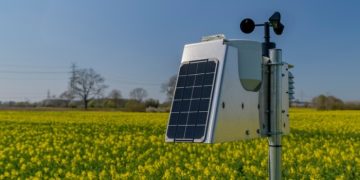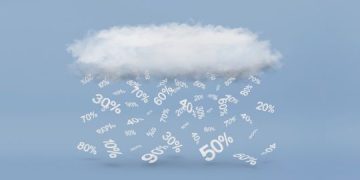Having an accurate reading of how much precipitation is in your backyard or farm can be essential for a variety of reasons such as proper water management, near-perfect weather forecasting, or an in-depth agriculture analysis. However, for you to have an accurate reading, you will need to be able to properly read your rain gauge. As simple as it may seem, getting an accurate reading from your rain gauge requires you to apply some tips, and in this post, we will walk you through all the tips and tricks you need to use and read a rain gauge properly.
Table of Contents
What Is A Rain Gauge?
A rain gauge is a meteorological instrument that is used to measure the amount of precipitation (mostly rainfall) that accumulates in a given area over some time. The term “precipitation” is used to refer to the various forms of water that fall onto the earth as a result of the condensation of water vapor in the sky– this can mean snow, rain, drizzle, ice sheet, ice crystals, hail, and many more. And if positioned correctly, a rain gauge can be used to measure these forms of precipitation. However, since rain is the most common form of precipitation, this article will focus on how to measure rain using a rain gauge.
How Does A Rain Gauge Work?
There are various types of rain gauges out there–which we will look into shortly– however, the general design and functionality of most rain gauges are the same.
Starting from the top, most rain gauges have an opening that collects water into the rain. The opening is often designed in the form of a funnel to effectively empty the water. The funnel design also minimizes or prevents the amount of debris that gets into the rain gauge, and this is essential because debris getting into the rain gauge can alter the accuracy of your reading; also, debris getting into the rain gauge will mean, you will have to clean the gauge often, and the funnel-like opening prevents all these from happening.
Once, the rain passes through the opening, it goes into a measuring tube or a tipping bucket, or a catching bucket (most digital rain gauges come with either a tipping bucket or a catching bucket).
How To Read A Rain Gauge:
This section will focus on how to read a standard rain gauge; this is because, with an electronic rain gauge, the readings will be shown on your console or smartphone, or tablet, hence it’s quite intuitive. All you will need to do is to choose the right unit(either metric or imperial system of measurement) to be able to make the right deduction.
However, with a standard rain gauge, you will have to know how to take the readings yourself to be able to make deductions. So, with that out of the way, let’s dive into how you can read a rain gauge accurately.
You might have noticed that the rain gauge has certain lines with numbers tagged to them. Well, these lines or calibrations are called “marks” and this is what we will be using for our reading.
The markings on your rain gauge can be categorized into two: The main markings and the harsh markings. Let’s take a look at each and how you can use them for accurate readings.
Starting with the main markings: These markings are usually prominent, and they are written in whole numbers. Also, the dimension of the rain gauge correlates to the number of main markings of the rain gauge. For example, a 5-inch rain gauge will have 5 main markings; thus, 1,2,3,4,5 calibrated on the rain gauge, with the distance between any two consecutive main markings being 1 inch.
That being said, some rain gauges do come with metric markings as well. However, they will usually come with an empirical marking as well. So, you can apply the steps here to obtain your reading.
Besides the main markings, you will notice that your rain gauge has certain mini markings on them; these “mini” markings are known as “hash marks.” And between any two main markings, you should see 9 hash lines.
That being said, not all rain gauges come with these lines. Some companies just add one hash line, which is set in the middle between two main markings and this should read as 0.5 of an inch. However, as a beginner, we highly recommend that you purchase a fully calibrated rain gauge. This means purchasing a rain gauge with 9 hash markings between each prominent marking to make the reading easier.
It is important to note that every marking on the rain gauge is an inch (1/10th of an inch). And the distance between any two consecutive main markings is 1 inch.
To accurately read your rain gauge, you want to keep the rain gauge at an eye level. And then, take a close look at the meniscus of the gathered water in the gauge. What you want to do is to look at the bottom of the meniscus and that should be the number of inches of rain for that day.
Once you see the point where the meniscus has settled, then you want to count from the bottom of the rain gauge up until the line the meniscus settles on, and divide it by 10, and that should be your reading.
So, for example, if the bottom of the meniscus falls on the 7th hash line above the 2-inch marking when you start counting from zero, up until the 7th hash mark above the 2-inch mark, you should get 27 counts, and when you divide it by 10, you should get 2.7 inches, and that should be your reading.
Tips For An Accurate Rain Gauge Reading:
Tip 1: Choose The Right Spot
Before you start any readings, knowing where to put a rain gauge will help you attain a more accurate reading. You must keep your rain gauge far away from shrubs, trees, bushes, or any obstruction. If there is a tree or a building, the rain gauge should be at a distance that is twice the height of that tree or building. This means, if the height of the building is say 2 meters, then you want to place your rain gauge at a 4-meter distance away from the building.
Placing your rain gauge at a far distance from obstacles is crucial because these obstacles could restrict the amount of water that gets into the gauge; hence, giving you false results. With an open area, nothing will be there to obstruct the amount of rain going into the gauge, and this is why you will often see many farmers or homeowners placing their rain gauge into the ground, on the fence, or walls with no upper covering.
Tip 2: When To Place It
The first step to accurately read the amount of rainfall with your rain gauge is to put the rain gauge outside for at least 45 mins before it rains. The idea here is to ensure that you set up the rain gauge while the weather is dry and sunny; however, if you want to set it up before it rains, it should be at least 45 mins before it does rain. This is important before it rains, it will probably start drizzling, and since drizzles are a form of precipitation, you want to ensure that your rain gauge captures the drizzle.
Therefore, make sure you check your weather report, and then set up the rain gauge at a proper period.
When setting your rain gauge up, you must ensure that it is up straight. Avoid tilting the rain gauge as it wouldn’t properly capture the total amount of rainfall when tilted.
Tip 3: Reading The Rain Gauge
Once you have everything ready, it is time to take your readings. But just before you rush and go outside to take your readings, we recommend that you wait 45 minutes after it has rained. Taking readings of your rain gauge 45 minutes after it has rained can help ensure that any initial runoff or splashback has had time to settle and that the measurement you are taking is an accurate representation of the total rainfall. Additionally, if you take the measurement soon after it starts to rain, the gauge may be at risk of overflowing before the storm is over.
That being said, do not also allow the collected rain to last for more than 24 hours before you take your readings. This is because it may vaporize and cause you to have an inaccurate reading.
Types Of Rain Gauge:
There are three main types of rain gauges for home, garden, and farm use.
Analog/Standard/Manual Rain Gauges:
These rain gauges have markings on them, and you will have to do the readings yourself as specified in this article.
Digital Rain Gauges:
These are stand-alone rain gauges that record the amount of rain using a rain sensor, and then transmit the readings to a display (this can be your phone or console). The readings are presented in numeric values, making them easier to understand. Some digital rain gauges also have a tipping bucket. And the number of times the tipping bucket tips will correspond to the amount of rainfall.
Home Weather Station with Rain Gauges:
These rain gauges work similarly to a digital rain gauge; however, the difference is that this type of rain gauge is usually part of a home weather station, hence its name.






